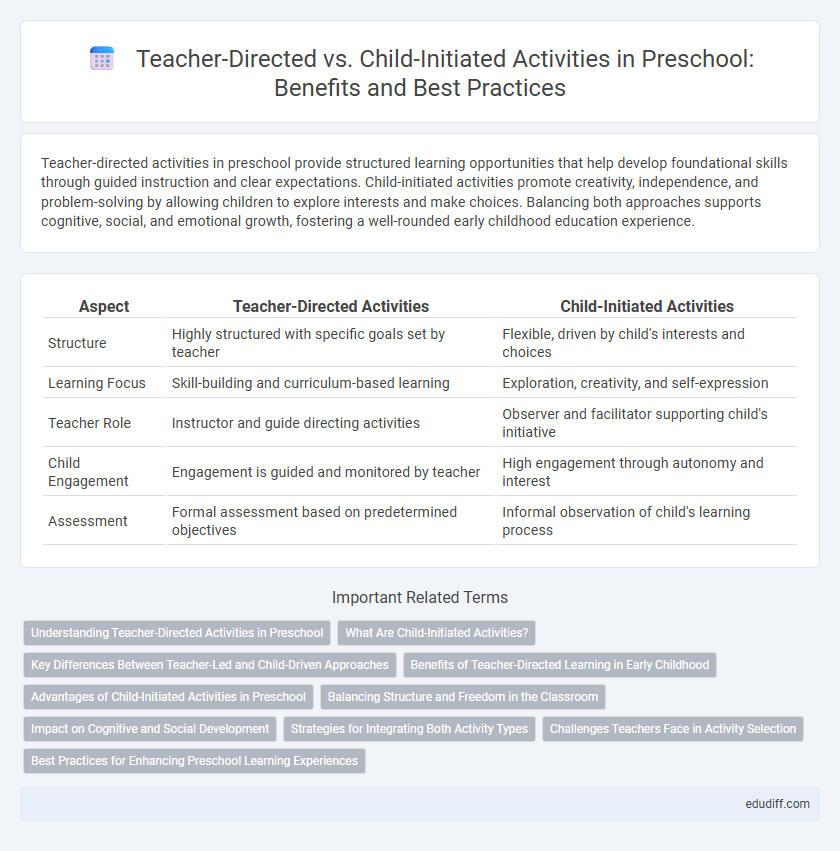Teacher-directed activities in preschool provide structured learning opportunities that help develop foundational skills through guided instruction and clear expectations. Child-initiated activities promote creativity, independence, and problem-solving by allowing children to explore interests and make choices. Balancing both approaches supports cognitive, social, and emotional growth, fostering a well-rounded early childhood education experience.
Table of Comparison
| Aspect | Teacher-Directed Activities | Child-Initiated Activities |
|---|---|---|
| Structure | Highly structured with specific goals set by teacher | Flexible, driven by child's interests and choices |
| Learning Focus | Skill-building and curriculum-based learning | Exploration, creativity, and self-expression |
| Teacher Role | Instructor and guide directing activities | Observer and facilitator supporting child's initiative |
| Child Engagement | Engagement is guided and monitored by teacher | High engagement through autonomy and interest |
| Assessment | Formal assessment based on predetermined objectives | Informal observation of child's learning process |
Understanding Teacher-Directed Activities in Preschool
Teacher-directed activities in preschool involve structured tasks led by educators, designed to achieve specific learning outcomes such as literacy, numeracy, and social skills. These activities provide clear guidance and input from teachers, supporting cognitive development through focused instruction and repetition. Implementing teacher-directed activities helps establish routines and foundational knowledge crucial for early childhood education success.
What Are Child-Initiated Activities?
Child-initiated activities in preschool are learning opportunities where children choose their own tasks, materials, and pace, promoting autonomy and creativity. These activities foster critical thinking, problem-solving, and social skills by encouraging exploration and decision-making within a supportive environment. Research shows that child-initiated play enhances cognitive development and motivation compared to strictly teacher-directed instruction.
Key Differences Between Teacher-Led and Child-Driven Approaches
Teacher-directed activities in preschool emphasize structured lessons and clear objectives guided by the teacher to develop specific skills such as literacy and numeracy. Child-initiated activities prioritize exploration and creativity, allowing children to choose tasks that foster self-expression, problem-solving, and social interaction. Key differences include the level of adult control, with teacher-led approaches focusing on curriculum goals, while child-driven methods support autonomy and intrinsic motivation.
Benefits of Teacher-Directed Learning in Early Childhood
Teacher-directed activities in early childhood foster structured learning environments where educators guide skill development through targeted instruction, enhancing foundational literacy and numeracy. This approach supports consistent behavior management and ensures curriculum goals are met, promoting cognitive growth and social-emotional regulation in preschoolers. Research indicates that teacher-led experiences help build essential routines, preparing children for the academic demands of primary education.
Advantages of Child-Initiated Activities in Preschool
Child-initiated activities in preschool foster creativity and critical thinking by allowing children to explore their interests at their own pace, leading to deeper engagement and intrinsic motivation. These activities promote social skills development as children collaborate and negotiate roles with peers, enhancing communication and cooperation. Research shows that child-initiated learning supports individualized development and autonomy, laying a strong foundation for lifelong learning and problem-solving abilities.
Balancing Structure and Freedom in the Classroom
Effective preschool environments balance teacher-directed activities that provide clear structure and learning objectives with child-initiated activities that foster creativity and independence. Structured activities guided by teachers develop critical skills in literacy, numeracy, and social interaction, while child-initiated play encourages problem-solving and emotional development. Integrating both approaches supports holistic growth and creates a dynamic classroom where children feel both guided and empowered.
Impact on Cognitive and Social Development
Teacher-directed activities in preschool provide structured learning experiences that enhance cognitive skills such as memory, attention, and problem-solving through guided instruction and targeted tasks. Child-initiated activities foster social development by encouraging creativity, decision-making, and peer interactions, promoting emotional regulation and cooperation. Balancing both approaches supports holistic cognitive growth and social competence, preparing children for future academic and interpersonal challenges.
Strategies for Integrating Both Activity Types
Balancing teacher-directed activities with child-initiated activities in preschool enhances cognitive and social development by combining structured learning and creative exploration. Strategies for integration include offering flexible schedules that allocate specific times for guided instruction and free play, using thematic units that connect teacher-led lessons with child-chosen projects, and encouraging teachers to observe children's interests to tailor activities that promote engagement and skill-building. Implementing these approaches ensures a holistic learning environment fostering independence, critical thinking, and collaboration.
Challenges Teachers Face in Activity Selection
Balancing teacher-directed activities with child-initiated activities presents challenges in ensuring developmentally appropriate learning outcomes. Teachers must navigate varying student needs and interests while adhering to curriculum standards and limited classroom resources. This complexity demands careful planning to foster engagement, autonomy, and skill-building in preschool settings.
Best Practices for Enhancing Preschool Learning Experiences
Teacher-directed activities in preschool provide structured learning opportunities that promote foundational skills through guided instruction and clear objectives. Child-initiated activities foster creativity, independence, and social-emotional development by allowing children to explore interests and engage in self-directed play. Balancing these approaches with evidence-based practices enhances cognitive, language, and motor skills while supporting holistic early childhood development.
Teacher-directed activities vs Child-initiated activities Infographic

 edudiff.com
edudiff.com